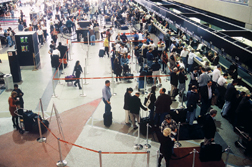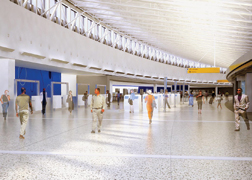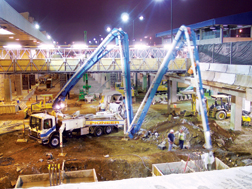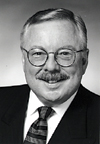
LAWA |

Gensler Congested ticket counters (Above) will give way to self-service kiosks that reduce the need for lobby space
|
It was a construction success story, of sorts. At Passenger Terminal World, in Amsterdam this April, Angela Newland described the project to renovate and expand Ohio’s Columbus Airport with a $7-million contract, $2-million change order and “flash-track” design and build process.
“We ordered steel before the terminal was designed,” the vice president of planning and engineering recalled. In half a year, the regional airport authority renovated almost 10,000 sq ft of operations and ticketing space and 11,000 sq ft of terminal lounges. By January 2007, it was ready for 500,000 annual passengers using the new hub airline Skybus. The airport began considering expansion phases two and three. Then, on April 4, 2007, “Skybus quit and filed for bankruptcy,” Newland said.
Airlines are merging, disappearing or shifting market focus. New technology- and security-related goals are coming, but nobody knows exactly when; the same goes for environmental regulations. The proposed hike of passenger facility charges from $4.50 to $7 has been on hold in Congress, and the government is pushing for more privatized operations.
 |
“There is a new normal, and it is always changing.” —william fife,
aviation vice president |
“There is a new normal, and it is always changing,” says Bill Fife, corporate vice president of aviation for DMJM+Harris, New York City. One standard remaining constant is that security, environment and evolving passenger needs must be integrated with the bottom line of not only a capital program but of the life cycle of an airport facility.
“You have to be pragmatic,” says Justin Jones, central division director of aviation for PBS&J, Tampa. “Rather than define the entire scope of a project up front, we work with the airline and the airport and look at the first items.”
Colleen Quinn, vice president of Ricondo & Associates Inc., Chicago, notes, “There was a time when facility planning and design were traditional [because the landscape wasn’t shifting so swiftly]. “Now, we’re looking at a time of transition, planning and designing for the unknown.”

D S / H J atlanta Airport Atlanta spent millions to create new security-required baggage rooms. Security trends require new facilities to be flexible
|
Shifting Terminal Spaces
The Transportation Security Administration, sometimes regarded as a harbinger of the unknown, unveiled at Baltimore-Washington International Airport a $1.1-million pilot program called Checkpoint Evolution, which BWI officials say required doubling a 60-ft-deep screening area to 120 ft. It features full-body imaging portals, new X-ray machines and ambient music.
At Hartsfield-Jackson Atlanta Internationl Airport, security requirements called for $180 million in work from 2004 to 2006, including 40-ft-deep excavations adjacent to the main terminal, says Dan Molloy, head of the capital improvement program. The work resulted in 67,000 sq ft and 54,000 sq ft of baggage screening space for the north and south terminals, respectively, with about four miles of new conveyer belts.
Fortunately, such complicated redos may not be necessary for the new $1.68-billion, 1.2-million-sq-ft international terminal, part of the airport’s $6.2-billion capital program. The terminal, the site of legal issues with a former design team and previous uncertainty over Delta Airlines’ future, is now under way with foundation work. One positive aspect of the delay of the terminal, originally scheduled to open in 2006, is that “even since the first design, we’ve seen changes we can take advantage of,” says Molloy. “For instance, we’ve been able to further reduce the ticketing space needed.”
The new terminal will accommodate future technology for remote check-ins at the consolidated auto rental facility. “We’re exploring ideas to enhance the arriving international passenger experience,” adds Molloy. “Gate-docking systems, spas, other concessions, registered traveler programs—all these things are on our plate. We’re open to any technology that can enhance operational efficiency.”
 |
| STEINERT |
Technology-influenced design is definitely moving beyond the shrinking ticket lobby. “Ticket halls will disappear,”predicts Ron Steinert, principal with Gensler, San Francisco. As a new generation of travelers rely on bar-coded tickets via cellphones, at-home boarding-pass printouts and off-airport kiosks, he suggests it is the baggage-claim area that should be the grand space—“a celebration of arrival, not departure.” As cost-conscious airlines give up traditional branding, “people are saying that we’re not far from a time when the first time you meet your airline is when you get on the plane,” he adds.
Richard Marchi, senior adviser of policy and regulatory affairs with the Airports Council International-North America, Washington, D.C., agrees. “I’m not advocating we return to 1960s architecture, but as far as the passenger service experience is concerned, we can use modern technology and make it feel like it was in 1962, [with] a quick-transaction, no-hassle security,” he explains.
To do so, more airports are starting to follow the high-tech path blazed by Las Vegas McCarran International Airport. It will let bids for a $1-billion, 1.87-million- sq-ft third terminal this month. The 14-gate terminal will be totally self-contained, with security checkpoints, baggage claim, concessions, parking and ticketing, says Rosemary Vassiliadis, deputy director of the Clark County Dept. of Aviation.
McCarran, quickly nearing its 53 million annual passenger capacity, is unable to expand further. As a result, it is leveraging technology to handle growth. For example, it uses Common Use Terminal Equipment (CUTE) at all gates. CUTE allows McCarran to move 30 airlines from gate to gate seamlessly. It accomplishes this by managing all software on its own server instead of 30 different IT ...
 Related Links:
Related Links: 
Post a comment to this article
Report Abusive Comment